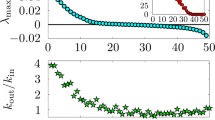Abstract
A primary motivation for research in digital ecosystems is the desire to exploit the self-organized properties of natural ecosystems. Ecosystems are thought to be robust, scalable architectures that can automatically solve complex, dynamic problems. However, the biological processes that contribute to these properties have not been made explicit in digital ecosystem research. Here, we discuss how biological properties contribute to the self-organized features of natural ecosystems. These properties include populations of evolving agents, a complex dynamic environment, and spatial distributions which generate local interactions. The potential for exploiting these properties is then considered. Theoretical and conceptually inspired from nature, the digital ecosystem could behave at large complex cycles of stability through alternate stable states. These approaches suggest that incorporating ideas from theoretical ecology can contribute to useful self-organized properties in digital ecosystems.
Preview
Unable to display preview. Download preview PDF.
Similar content being viewed by others
References
Ximbiotix, About the digital ecosystem (2006), http://www.ximbiotix.com/desktop/the-digital-ecosystem/about-the-digital-ecosystem.cfm
Fiorina, C.: The digital ecosystem, Hewlett Packard (2006), http://www.hp.com/hpinfo/execteam/speeches/fiorina/ceo_worldres_00.html
Syntel, Building your own digital ecosystem: a holistic approach to enterprise integration (2006), http://www.syntelinc.com/uploadedFiles/SyntelDigitalEcosystem.pdf
Silicom, Digital ecosystem (2006), http://www.silicom.com/de1.shtml
Vandenberghe, M.: The business factory - digital ecosystem solution (2006), http://themaddesigner.free.fr/XeWOW%20White%20Paper.pdf
Yaeger, L.: Computational genetics, physiology, metabolism, neural systems, learning, vision and behavior or polyworld: Life in a new context, in Artificial Life III, SFI Studies in the Sciences of Complexity, Langton, pp. 263–298. Addison-Wesley, Reading (1993)
Ray, T.S.: An approach to the synthesis of life. Artificial Life II. Santa Fe Institute Studies in the Sciences of Complexity, vol. XI, pp. 371–408. Addison-Wesley, Redwood City (1991)
Adami, C., Brown, C.T.: Evolutionary learning in the artificial life system “avida”. In: R.B., Maes, P. (eds.) Artificial Life IV: Fourth International Workshop on the Synthesis and Simulation of Living Systems, pp. 377–381. MIT Press, Cambridge (1994)
Pargellis, A.N.: Digital life behavior in the amoeba world. Artificial Life 7, 63–75 (2001)
Ofria, C., Wilke, C.O.: Avida: a software platform for research in computational evolutionary biology. Artificial Life 10, 191–229 (2004)
Digital Business Ecosystems project, EU Framework 6 Integrated Project (2006), http://www.digital-ecosystem.org/
Callebaut, W., Rasskin-Gutman, D. (eds.): Modularity. Understanding the Development and Evolution of Natural Complex Systems. MIT Press, Cambridge (2005)
Gallagher, S., Varela, F.J.: Redrawing the map and resetting the time: Phenomenology and the cognitive sciences. Can. J. Phil. 29, 93–132 (2001)
Varela, F.J., Thompson, E., Rosch, E.: The Embodied Mind: Cognitive Science and Human Experience. MIT Press, Cambridge (1991)
Noë, A.: Action in Perception. MIT Press, Cambridge (2005)
Noë, A.: Experience without the head. In: Perceptual Experience. Edited by Tamar Szabo Gendler and John Hawthorne, OUP (2006)
Polis, G.A., Anderson, W.B., Holt, R.D.: Toward an integration of landscape and food web ecology: the dynamics of spatially subsidized food webs. Annu. Rev. Ecol. Syst. 28, 289–316 (1997)
Polis, G.A., Power, M.E., Huxel, G.R.: Food webs at the landscape level. University of Chicago Press, Chicago (2004)
Werner, E.E.: Size, scaling and the evolution of complex life cycles. In: Size-structured Populations, pp. 60–81. Springer, Berlin (1988)
Wilbur, H.M.: Complex life-cycles. Annu. Rev. Ecol. Syst. 11, 67–93 (1980)
Werner, E.E., Gilliam, J.F.: The ontogenetic niche and species interactions in size structured populations. Annu. Rev. Ecol. Syst. 15, 393–425 (1984)
Polis, G.A., Meyers, C.A., Holt, R.D.: The ecology and evolution of intraguild predation: potential competitors that eat each other. Annu. Rev. Ecol. Syst. 20, 297–330 (1989)
Knight, T.M., McCoy, M.W., Chase, J.M., McCoy, K.A., Holt, R.D.: Trophic cascades across ecosystems. Nature 437, 880–883 (2005)
Beltrami, E.: Mathematics for Dynamic Modeling, 2nd edn. Academic Press, London (1998)
Royama, T.: Population dynamics of the spruce budworm Choristoneura fumiferana. Ecological Monographs 54(4), 429–462 (1984)
Scheffer, M., Carpenter, S., Foley, J.A., Folke, C., Walker, B.: Catastrophic shifts in ecosystems. Nature 413, 591–596 (2001)
Scheffer, M., Carpenter, S.R.: Catastrophic regime shifts in ecosystems: linking theory to observation. Trends Ecol. Evol. 18, 648–656 (2003)
Schröder, A., Persson, L., De Roos, A.M.: Direct experimental evidence for alternative stable states: a review. Oikos 110, 3–19 (2005)
Polis, G.A., Holt, R.D., Menge, B.A., Winemiller, K.O.: Time, space, and life history: influences on food webs. In: Polis, G.E., Power, M.E., Huxel, G.R. (eds.) Food Webs: Integration of Patterns and Dynamics, pp. 435–460. Chapman & Hall, New York (1996)
Nakano, S., Murakami, M.: Reciprocal subsidies: Dynamic interdependence between terrestrial and aquatic food webs. Proc. Natl. Acad. Sci. U.S.A 98, 166–170 (2001)
Marczak, L.B., Thompson, R.M., Richardson, J.S.: Meta-analysis: trophic level, environment, and productivity shape the food web effects of resource subsidies. Ecology 88, 140–148 (2007)
MacArthur, R., Wilson, E.O.: The Theory of Island Biogeography. Princeton University Press, Princeton (1967)
Hubbell, S.: The Unified Neutral Theory of Biodiversity and Biogeography. Princeton Univ. Press, Princeton (2001)
Author information
Authors and Affiliations
Editor information
Editors and Affiliations
Rights and permissions
Copyright information
© 2008 Springer-Verlag Berlin Heidelberg
About this paper
Cite this paper
Lopardo, G.A., Rateb, F.N. (2008). Chaos and Budworm Dynamics of Agent Interactions: A Biologically-Inspired Approach to Digital Ecosystems. In: Gelbukh, A., Morales, E.F. (eds) MICAI 2008: Advances in Artificial Intelligence. MICAI 2008. Lecture Notes in Computer Science(), vol 5317. Springer, Berlin, Heidelberg. https://doi.org/10.1007/978-3-540-88636-5_84
Download citation
DOI: https://doi.org/10.1007/978-3-540-88636-5_84
Publisher Name: Springer, Berlin, Heidelberg
Print ISBN: 978-3-540-88635-8
Online ISBN: 978-3-540-88636-5
eBook Packages: Computer ScienceComputer Science (R0)




